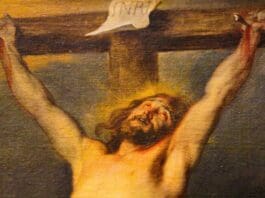
Good Friday sits solemnly within Holy Week, a day marked by fasting and penance, reflecting on Christ’s crucifixion and death. For believers, this day isn’t merely a historical remembrance but a profound contemplation on the sacrifice of Christ, central to Christian faith. The Catholic Catechism encapsulates this, attributing our justification to Christ’s Passion, where he, as a living sacrifice, pleasing to God, atones for humanity’s sins with his blood (CCC 1992), echoing St. Paul’s words on grace, redemption, and faith in Christ’s expiation (Romans 3:24-25).
This day’s customs and prayers deeply engage with the theme of Christ’s sacrificial love. From sunset on Good Friday, the Paschal Triduum’s second day begins. The primary services occur in the afternoon, around 3:00 PM, symbolizing the hour of Jesus’ passing. Western traditions for observing Good Friday include the Passion reading or singing from St. John’s gospel, particularly covering John 18:1-19:42 in the Catholic Church. Another widespread practice is the Veneration of the Cross, where the faithful show reverence to a wooden cross through kneeling or kissing.
The day also observes the “Mass of the Pre-Sanctified,” since no Masses are celebrated on Good Friday or Holy Saturday. Thus, the Eucharist from Maundy Thursday’s Mass is used. The Stations of the Cross, or the “Way of the Cross,” is a devotion commemorating fourteen events leading up to Jesus’ death, marked by stations throughout many Catholic churches.
Less common now, the “Tre Ore” or “Three Hours” service reflects on the seven last words of Christ, a tradition initiated by Jesuit Alphonso Messia in 1732 and embraced by many Protestant churches. Good Friday, alongside Ash Wednesday, remains a day of official fast in the Catholic Church.
The Eastern Churches observe “the Great Friday” with distinctive customs. The day starts with Matins, featuring the “Twelve Gospels” reading. The “Little Hours” follow, culminating in Vespers with the veneration of the epitaphion and concluding with Compline’s lamentation.
A symbolic burial of Christ is performed on Good Friday night. In some traditions, the customary greeting of “peace be with you” is replaced due to its association with Judas’ betrayal. In Russia, a silver coffin with a painted image of Christ is venerated by the faithful.
The practice of Good Friday observance traces back to ancient times, with some customs documented as early as the 4th century by Egeria. Its evolution into a day of penance and fasting commemorates Christ’s death, with the name “Good Friday” possibly originating from “God’s Friday.” The veneration of the cross likely began in Jerusalem between the 7th and 8th centuries, with references to pre-sanctified Masses dating back to the Quinisext Council in AD 692.
Good Friday’s observance transcends Catholic and Eastern Orthodox Christians, with Anglicans, Methodists, and Lutherans also marking the day in reverence and reflection.
Photo credit: jorisvo / Shutterstock.com
The post Good Friday appeared first on uCatholic.
Daily Reading
Memorial of Saints Basil the Great and Gregory Nazianzen, Bishops and Doctors of the Church
Readings for the Memorial of Saints Basil the Great and Gregory Nazianzen, Bishops and Doctors of the Church Reading 1 1 John 2:22-28 Beloved: Who is the liar? Whoever denies…
Daily Meditation
A Voice in Today’s WildernessUna voz en la jungla de hoy día
Click here for daily readings Today’s Gospel passage is especially relevant as we begin a new year with resolutions and hope. In this reading we hear John’s declaration echoing the…




